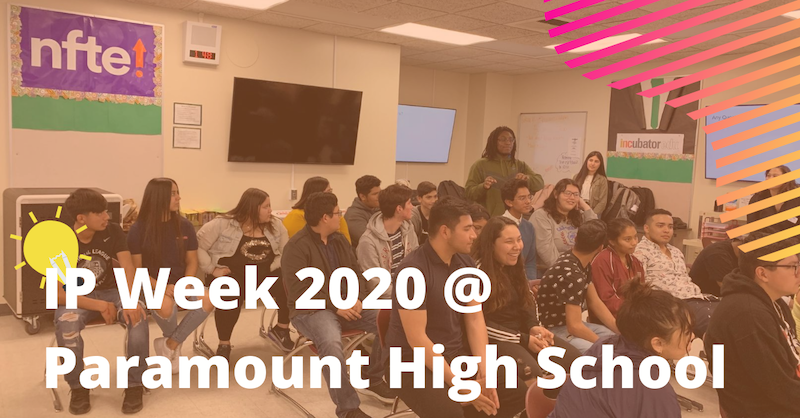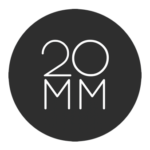Overview
The long-term economic damage posed by the COVID-19 crisis may unfortunately hit many of the world’s young workers the hardest. As noted by the Atlantic Council, many entry-level or lower skills jobs that employ youth are in retail and services (including hospitality, food, and beverage)— industries that are highly susceptible to a sudden drop in consumer spending. Entrepreneurship and invention education has the potential to become a fundamental tool for engaging students in creativity and problem-solving while in school, and later helping to provide the skills needed to reverse the youth unemployment crisis.
This spring, Michelson IP, Network for Teaching Entrepreneurship (NFTE) Los Angeles, and Paramount High School in Los Angeles County partnered on an “IP Week” pilot to integrate intellectual property (IP) subject matter into NFTE’s entrepreneurship curriculum. Intellectual property is an essential component of any business, and we believe this knowledge will be an asset to students who decide to embark on an entrepreneurial journey.
Whether you’re continuing virtual distance learning this fall or preparing for in-person instruction, we’re sharing key lessons learned for integrating IP into your curriculum while keeping students engaged.
Step 1: Be clear on your Learning Objectives
Intellectual property can be a complex and highly technical topic. It’s best introduce the larger concept of IP and then zoom in on specific IP topics, depending on the focus of your course or lesson. Whether it be invention, entrepreneurship fundamentals, brand building, or even design thinking, choose IP topics that are most relevant to your subject matter and your students’ indicated interests and goals. Some example deep-dive topics may include criteria for patenting, or copyright fair use and infringement examples.
During IP Week with NFTE, educators utilized a 60 minute PowerPoint presentation designed for high school students (available on our Educator Portal) to broadly introduce IP.
Step 2: Plan pop culture relevant content to supplement your lesson plan
Keep learning about IP fun and relevant with clips like this one from the talk show Last Week Tonight with John Oliver before delving into the day’s curriculum. The humorous clip features the reality show Shark Tank, where the potential investors, or “sharks”, are apparently big fans of patents.
Our Basics of IP video series is another form of fresh content on IP. This YouTube clip highlights the “Blurred Lines” copyright infringement case between the Marvin Gaye estate and Robin Thicke/Pharrell Williams, as well as another case involving Tom Petty and Sam Smith.
Step 3: Keep students engaged with a stimulating group activity
There are a variety of activities that can be used to supplement your IP curriculum. The USPTO has a great resource guide with lesson plans for high school students. This Design-An-Invention prompt works well as an icebreaker for the beginning of class to get creative/critical thinking skills going. Going virtual? No problem. Online whiteboards are a great way to engage in digital hands-on activities. Consider utilizing applications like MURAL or Google Jamboard to make these interactive activities work in the virtual environment.
National Geographic also has a well organized activity plan–complete with curated video–for students to investigate types and examples of intellectual property to understand the importance of it in their daily lives.
Step 4: Tap your networks to plan for a guest speaker
Invite IP subject matter experts to field questions from students, share real-world examples and further illuminate the topic of IP. If you’ve shifted to virtual instruction, it will likely be even easier to attract interesting speakers for your online event. Be sure to prep your speakers on what your students have been studying and themes from your discussions. Have your students prepare questions for the speakers in advance, as well. Some popular general questions during our IP Week panel included:
- How early should an entrepreneur or inventor begin to think about IP?
- What are the most common IP mistakes you’ve witnessed and could they have been avoided?
- What resources are out there to help young inventors or entrepreneurs conduct patent or trademark searches or file for IP protection?
Feel to reach out to us here at Michelson IP if you need speaker suggestions!
Step 5: Share self-paced, independent learning resources with your students
Towards the end of your IP curriculum, consider curating and distributing a list of resources for students who desire to explore the topic of IP on their own time, or as they develop their business or invention plans. We recommend our free online course, “Intellectual Property: Inventors, Entrepreneurs, Creators.”
Good luck with your IP lesson plans! Looking for more resources, or want to share additional tips and insights with us? Contact Program Coordinator, Rachelle at [email protected].
Download the Free Infographic Below
_________
The Michelson Institute for Intellectual Property, an initiative of the Michelson 20MM Foundation, provides access to empowering IP education for budding inventors and entrepreneurs. Michelson 20MM was founded thanks to the generous support of renowned spinal surgeon Dr. Gary K. Michelson and Alya Michelson. To learn more, visit 20mm.org.




